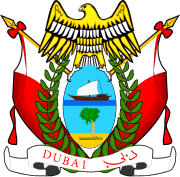Al-Falasi
| House of Al Falasi بيت الفلاسي |
|
|---|---|

Coat of arms of Dubai
|
|
| Country | United Arab Emirates |
| Estates | Zabeel Palace |
| Titles | |
| Style(s) | His/Her Highness |
| Founded | 1833 |
| Founder | Al Maktoum |
| Ethnicity | Emirati |
The House of Al Falasi (Arabic: بيت الفلاسي) is associated with the history of the ruling royal family of Dubai.
The Al Maktoum family descends from the Al Bu Falasah (now known as Al-Falasi) section of the Bani Yas, a tribal federation that has been the dominant power throughout most of what is now the United Arab Emirates. In 1833, a large, influential group of the Bani Yas moved to Dubai under the leadership of Maktoum bin Butti bin Sohal. The Al Maktoum family, a part of the Al Bu Falasah section of the Bani Yas, continues to rule Dubai to this day.
During the early days of 1894, Sheikh Saeed bin Maktoum bin Hasher Al Maktoum (Ruler from 1912-1958) convinced merchants from India and Iran to stay in the city; thus assuring zero taxation. A more modern cosmopolitan city as well as a business friendly orientation was later established, which is what Dubai is now known for. By the 1930's the population of Dubai nearly reached 20,000, where a quarter of those were Expatriates. However problems formed, in the 1950's the Dubai Creek began to slowly crack due to the escalating number of ships that occupied it. The late Ruler of Dubai Sheikh Rashid bin Saeed Al Maktoum had an ambitious vision to dredge the waterway; the pivotal move resulted in an increase volume of Cargo handling in Dubai. Ultimately, reinforcing and restrengthening Dubai's position as a re-export hub and larger trading.
The old Dubai was slowly diminishing until 1966 when oil was founded in the Fateh Oil Field. At diverse times making a living out of strong trades in gold and pearls which was often exported as well as other commercial activities and serving major regional hub. The first tank of oil was exported from Fateh Oil Field on the 22 September 1969, therefore allowing Dubai to finance its developments and later evolve into modern history through various projects brand new to the Middle East region and the Persian Gulf.
...
Wikipedia
